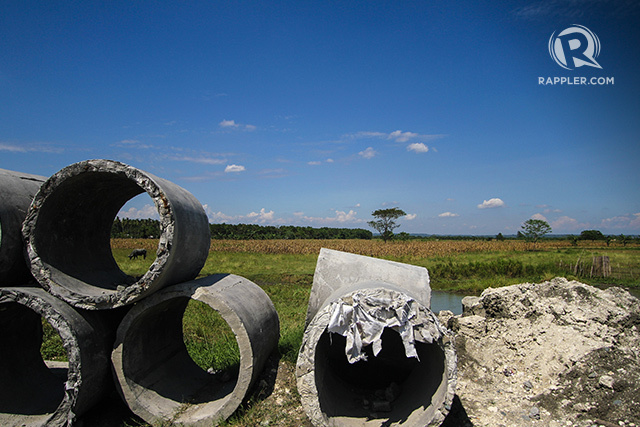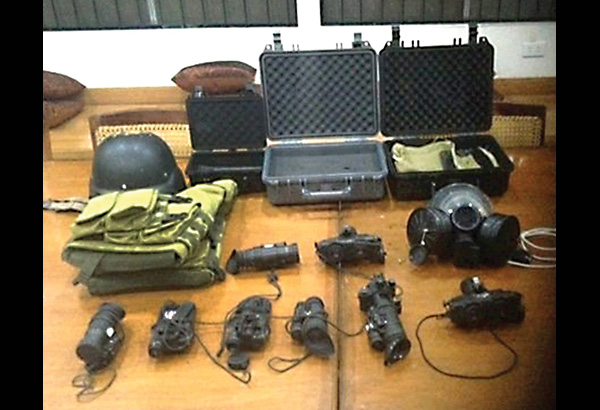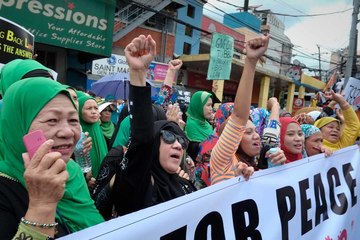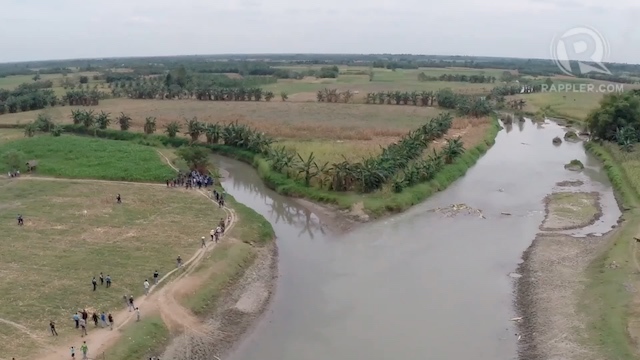From Rappler (Mar 20):
Mamasapano: Time on Target
It is difficult to accept that some failure to coordinate can lead to the blood of 44 policemen splashed across a cornfield south of the country
 WHERE THEY FELL. The cornfields of Tukanalipao. Photo by Patricia Evangelista / Rappler
WHERE THEY FELL. The cornfields of Tukanalipao. Photo by Patricia Evangelista / Rappler
It started going wrong before dawn.
They came in the dark, dropping out of vans and trucks at the far end of the Tukanalipao highway. They marched through the wet fields, cutting through scarecrow stalks, humping grenade launchers and assault rifles and belts of ammunition slung across the ceramic plates of tactical vests, 300 bullets to a man.
There was a quarter moon overhead. The enemy was asleep. Their commander had told them that there could be enemies everywhere, but they would own the night.
They were the 84th Seaborne, the elite of the elite, the bulletproof boys of the Special Action Force trained by Uncle Sam. They had fought in urban hellholes, had seen mortars fall out of the sky, had survived prison breaks and alleged coups, and long weeks of lying behind sandbags watching the horizon.
They had days of practice in Zamboanga, but Zamboanga wasn’t Maguindanao. The small town of Mamasapano was rebel country, and the fighters of the Moro Islamic Liberation Front (MILF) were not the only men who slept that night. The MILF’s breakaway group, the Bangsamoro Islamic Freedom Fighters (BIFF), roamed the far end of the marshes. There were private armies, and M16s in the houses of farmers who had learned the hard way that justice comes from the barrel of the gun.
The enemy, when roused, could number in the thousands, and there were only 38 Seaborne crossing rivers whose GPS had just failed.
It took 6 hours, carrying equipment through muddy rivers and long stretches of flatland. They asked their guides to take over when navigation failed, but the guides got lost in the dark. They were late, an hour, two hours, and then they had to leave men behind at the last river.
When they finally arrived at their target in the village of Pidsandawan, they were 25 men and several radios short. Dawn was coming. They were running out of time.
They could have walked away, then and there, the same as they did in other missions. But Operation Exodus had no abort criteria.
At 4 in the morning of January 25, 2015, 13 men from the 84th Seaborne moved in to neutralize a bomb maker named Zulkifli Bin Hir, alias Marwan. It was impossible to hit 3 targets at once, so the two other targets, Abdul Basit Usman, and Amin Baco, alias Jihad, were left alone in favor of Marwan.
At 4:20 am Marwan was dead. They cut off his finger. They took their pictures. And then the firing started. Mortars fell, snipers took position, the gunfire raged like thunder as the men of the BIFF jumped into the fray. The 84th, lightly equipped, trained for operations with support bases ready to assist, were overwhelmed. They fired back.
When the sun rose, the enemy owned the day.
Death penalty
“Why is it,” demands Senator Alan Peter Cayetano, "that when the PNP or AFP fail to coordinate, they are punished with the death penalty?”
Coordination is an innocuous word. Its associations are inoffensive, the crack of its consonants do not pulse with necessity. It is a process, an exchange, an attempt at integration. It is not a word that leaps from privilege speeches into primetime newscasts, unlike “terrorist” or “hero.”
Certainly it is difficult to accept that some failure to coordinate can lead to the blood of 44 policemen splashed across a cornfield in the country's south. There must be some other reason behind the deaths of 67 people, some evil afoot, some grave and fundamental trouble beyond basic incompetence that can explain the horror of one Sunday in January. People are dead. Children are orphaned. Wives are now widows. It is easier to speak of traitors and patriots and the betrayal of Moro brothers. We must die for the sake of peace. We must be willing to kill in the name of justice. We are one nation, under God. If we broke the ceasefire, if we failed to coordinate, it is not our fault. We do not negotiate with terrorists.
Cayetano points a finger at MILF chief negotiator Mohagher Iqbal.
“Why is it that when it comes to our military and police, when they enter your area, your answer is always, ‘No coordination?’”
Cry havoc, brothers. Let slip the dogs of war.
The new strategy
The plan was called Exodus. The targets were high-value terrorists. The contents of the intelligence packet – built with the assistance of the United States – included a location in a remote area of Mamasapano.
Mamasapano offered a series of complications. Protocols under a ceasefire agreement signed between the MILF and the government required prior coordination before armed operations in MILF bailiwicks.
In their assessment, the SAF marked the MILF as enemy troops. The operation was planned for 2 am, while locals were asleep. The SAF were to have the advantage of night vision goggles.
A map was drawn up, dividing the route into waypoints. The 84th Seaborne would compose the main effort, 38 commandos whose duty was to neutralize the 3 targets. The 55th SAC would be their blocking force stationed behind them. Three other teams – the 41st, the 42nd, and the 45th – would be dispersed at waypoints along the route, ready to link up with the main effort as they exited Mamasapano. It was, as the police described it, a way-in, way-out, by-foot, night-only infiltration.
This was not the first operation in pursuit of Marwan. Nine operations had been attempted since 2010. Five were aborted. Another 4 had failed.
This time, for Exodus, a new element was added to the operational plan. It was a coordination strategy that timed the release of information about the operation to the moment of the main effort’s arrival at the target area.
Nobody outside the SAF planners would know, not even the current police director.
The former SAF director gave the coordination strategy a name.
He called it “time on target."
Coddlers of terrorists
Getulio Napeñas, 55, is a graduate of the Philippine Military Academy class of 1982. By his own accounting he has two master's degrees and a Level 7 Executive Diploma on Strategic Leadership from the United Kingdom. He has undergone the Special Action Force Ranger Course, followed by the Urban Counter Revolutionary Warfare Course, and has taken specialized intelligence courses in London and Arizona. He also read aloud every course he attended under the Anti-Terrorism Assistance Program of the US State Department – Integrating Counter-terrorism Strategies at the National Level, Police Leader’s Role in Combating Terrorism, Senior Level Crisis Management and Vital Installation Security.
“I can look at anyone, and I mean anyone,” he tells the Senate, “and tell him face to face that I worked my way up the ladder not because of my connections but because of my performance, perseverance, dedication, credibility and dignity and integrity.”
Napeñas, whose head with its bowl-cut bob jerks as he reads from his speech, does not trust the armed forces. He attributes aborted operations in pursuit of Marwan to the Armed Forces of the Philippines (AFP). Police say he “speculated that sensitive information and operational information” were “deliberately leaked” during major operations, had “lamented” that high value targets were “being coddled by the MILF, whose members had a lot of contacts within the AFP.”
Napeñas was already clear that he believed the MILF to be an enemy force. It appeared he considered the possibility members of the AFP were the enemy as well.
Prior warning to the AFP, Napeñas told the Senate, would mean “compromising the operations again.”
Napeñas’ time-on-target (TOT) is new coordinating parlance for both the PNP and the AFP. It is not part of any established protocol, and has had no application in previous field operations. According to the BOI, based on interviews with involved SAF personnel, their understanding of time on target coordination was shaky at best.
Napeñas said he was not alone in approving the strategy. He said he presented his “new concept of operations” to President Benigno Aquino III at a meeting attended by former PNP chief Alan Purisima.
“Based on the records,” said a report by the PNP Board of Inquiry, “Oplan Exodus was approved by the President and implemented by suspended CPNP Purisima and other suspended PNP officers, to the exclusion of the Officer-in-Charge of the Philippine National Police Leonardo Espina.”
The best of friends
To understand Mamasapano means understanding the odd strength of the President’s loyalty to Alan Purisima. Purisima is the old friend, the shooting buddy, the large man with the cherubic face who protected the young Aquino from the bloody coups of the 1980s. On the day Alan Purisima was charged with graft in 2014, he was the director of the Philippine National Police, and the only 4-star general in the service.
When the complaints first went public, the President said Purisima was neither luxurious nor greedy. When Purisima offered to resign more than a week after the Mamasapano encounter, the President said it hurt to accept his resignation.
“Nothing,” Aquino once said, “can compare to our friendship.”
It was Purisima who had been briefed about Napeñas’ new operational plan, who had escorted Napeñas to the Palace to brief the President, who had continued to “listen” and “advise” and “suggest”– all while he was on preventive suspension at the orders of the Office of the Ombudsman.
Six weeks after he discovered the failure of Operation Plan Exodus, Benigno Aquino III, President of the Republic, Commander-in Chief of the Armed Forces of the Philippines, stood on a podium and informed the nation that he had
no responsibility over the deaths of 67.
Even before a public investigation had concluded, the President offered a culprit, one Getulio Napeñas, who was relieved of duty the day after Mamasapano.
The accusations the President levelled against Napeñas were immense. Failure to plan. Failure to coordinate. Failure to abort. Failure to report the situation truthfully and well. Failure, most of all, to follow the direct orders of his commander-in-chief.
“Maybe the most generous way of looking at it is that there’s a lot of wishful thinking from Napeñas as opposed to reality. But it’s clear to me – he misled me. Now, what is my responsibility at this point in time? There’s a saying, fool me once, shame on you; fool me twice, shame on me.’”
'Advice'
Yet it is not the first time during Operation Exodus that the President played the fool. He believed Napeñas and Purisima when they presented a plan that did not consider terrain, timing, and ground support. He believed the veracity of mission updates sent by Purisima throughout January 25. He believed that excluding the legal head of the PNP in favor of his good friend was proper procedure. He believed, and continues to believe, that he has no responsibility as the President of the Republic.
When his beliefs were questioned, he said he was misled and deceived. The plan, he said, appeared “thorough” when he approved it.
“Oplan Exodus can never be executed effectively because it was defective from the very beginning,” read the PNP
Board of Inquiry (BOI) report. “Troop movement was mismanaged, troops failed to occupy their positions, there was lack of effective communication between the operating troops, command and control was ineffective, and foremost, there was no coordination with the AFP and peace mechanism entities.
”
It is not clear who approved time on target coordination.
Aquino said he ordered Napeñas to coordinate with the AFP.
Napeñas said Purisima ordered him not to coordinate.
Purisima said his directives were advice, not orders.
On January 25, 2015, because of a new coordination strategy that may or may not have been approved, and a plan that may or may not have been complete, the commandos of the Special Action Force were ordered to execute a mission without a commitment of support from the armed forces.
They entered an armed enclave without understanding the terrain, without advice from the ceasefire committee, without the knowledge of both local and national police chiefs, and under the supervision of a suspended police general and a President who turned off his phone as troopers walked to their death.
The 24-hour exception

SCENE OF THE CLASH. The cornfield in Barangay Tukanalipao, where elite cops clashed with rebel forces. Photo by Karlos Manlupig/Rappler
Operation Plan Exodus may not have had abort criteria, but there were two mitigating actions built into the plan in case of heavy fire – artillery support from the AFP and an immediate ceasefire by the peace panel.
Two mechanisms were part of the Agreement on the General Cessation of Hostilities: the Ad Hoc Joint Action Group (AHJAG) and the Coordinating Committee for the Cessation of Hostilities (CCCH).
Each mechanism has government (GPH) and MILF components. The joint AHJAG coordinates between government forces and the MILF to facilitate law enforcement operations. The joint CCCH responds to hostile and armed confrontation. Its mandate is to prevent and de-escalate conflict.
The protocols were an attempt to avoid armed men from shooting first and asking questions later. The questions were to be answered before they were asked, the allies named before the guns spat fire.
Among the many debates during the Senate inquiry was Napeñas’ insistence that the SAF did not violate ceasefire mechanisms put in place after the beginning of peace process negotiations.
Napeñas quoted the 2002 Joint Communiqué signed in Kuala Lumpur, Malaysia, by the MILF and the Philippine government.
“Except for operations against high priority targets,” read the agreement, “the AHJAG is required to inform the GPH and the MILF CCCH at least 24 hours prior to the conduct of the AFP or PNP operations” to allow for the evacuation of civilians and to avoid armed encounters.
It is on the 24-hour clause that Napeñas bases his choice to use TOT coordination.
“There is a exception in this part, Your Honor, that this is a high value target being pursued by the Special Action Force, sir, at this time.”
Napeñas was correct there was an exception, but failed to note that the clause “the AHJAG is required to inform the GPH and MILF CCCH” did not refer to the police or armed forces. The 24-hour exception allows the GPH-AHJAG, in cases of law enforcement operations with high value targets, to determine how much time, if at all, will be given to the GPH-CCCH and MILF-CCCH to prepare.
Had Napeñas chosen to read the
revised implementing rules signed on July 23, 2013 by AFP Chief of Staff Emmanuel Bautista, Purisima, and Peace Panel Chair Miriam Coronel-Ferrer – an agreement that “provides for the amendment of all policies and other guidelines” – he would have discovered the specific demand the communiqué makes on all government forces.
Phase 1, which covers the preparation period before law enforcement operations, requires that “GPH forces” – the police and armed forces – to “communicate to the GPH-AHJAG of an impending law enforcement operation at least 24 hours prior.”
There are no exceptions to this clause.
The encounter at the cornfield
Mama Dagadas woke to gunfire past 4 in the morning of January 25. He picked up his M16 and left for a clearing behind a stand of coconut trees. He was not in any particular hurry. The clearing, situated behind a cornfield below the Tukanalipao footbridge, was the meeting place for the MILF living in Tukanalipao, whose operating procedure was to gather at the sound of gunfire.
Dagadas had joined the MILF when he was 20, along with almost every young man he knew. He was a tall, spare man with a long face, the son of a farmer who had made it to 6th grade and had no further ambition beyond pulling in the next harvest. He was married at 36, and was the father of a 3-year-old boy named Maher.
The rebels came, one by one, cousins and friends. There had been gunfire, and gunfire meant they had to gather and wait for the commander to cut across the town proper, cross the footbridge, walk across the cornfields and tell them what to do.
What they did not know was that in front of them, under the corn, waited the 55th Special Action Force. The 55
th had been attempting to reach their assigned waypoint when they heard gunfire from Pidsandawan. They took over the cornfields at the bottom of the Tukanalipao footbridge to protect the 84
th’s exit.
It was a location that provided concealment, not cover.
Napeñas radioed an order for the 55th to stand their ground and engage the enemy.
"If you identify them as the enemy and if they armed, do not let them come close. Engage."
About a dozen fighters from the 105th Base Command of the MILF were crossing the footbridge to the cornfield when two of their men were shot down.
“That was when we joined in,” Dagadas said.
PO2 Christopher Lalan, lone survivor of the 55th Special Action Company, said it was the MILF who shot first.
It was 5:20 in the morning. By 5:30, the SAF were pinned down by an enemy that “peppered them with heavy gun-fire, rocket-propelled grenade, and M203 grenades from different directions.”
Mama Dagadas may or may not have killed before, but he certainly tried his best that Sunday morning, when he crouched at dawn among the coconut trees and shot at the enemy hiding in the cornfields of Tukanalipao, Mamapasano, Maguindanao.
“We couldn't see the people there because there were corn plants,” he said. “They were under the corn. We didn't know who we were fighting. We hadn't seen them yet.”
The encounter lasted hours. Reinforcements arrived from the BIFF. Bullets ran out. Radios failed. Ordnance refused to fire. The last to send a message, SAF radioman Senior Inspector Ryan Pabalinas, died with 16 gunshot wounds to the body.
It ended at one in the afternoon. The 55
th SAF had gone silent.
The war room
In the coordination matrix Napeñas presented to the Senate, time on target notification would rest on himself as SAF Director.
The operational plan for Exodus marked 4 parties that required immediate notification at TOT – the AFP’s 6th Infantry Division (6th ID), the 1st Mechanized Brigade (1st MIB), the AJHAG and the CCCH.
Following Napeñas definition of time on target, notifications should have been released at 4 am, immediately after the 84
th Seaborne reached Marwan’s hut in Pidsandawan.
Of the 4 parties in the coordination matrix, the SAF informed 3, more than a full hour after time on target.
The 6th ID’s Commander, Major General Edgardo Pangilinan, was sent a message at 5:06 am. He saw it at 6 am.
The 1st MIB’s Commander, Colonel Gener Del Rosario, was sent a message at 5:20 am. He saw it at 6:19 am.
The GPH-AHJAG Chair, Brigadier General Manolito Orense, received a phone call from Napeñas at 5:38 am.
The CCCH were not notified.
The first messages were variations on the same theme: the PNP-SAF was entering Mamasapano to serve warrants of arrest to high value targets with the support of the Maguindanao Provincial Police Office.
“For your info, on January 25, 2015 at about 0230H, PNP-SAF supported by MagPPO PRO ARMM shall be conducting LEO and serve WA against HVTS in Mamasapano, Mag.”
The messages said that coordination “was also done” with the 6th ID, the 45th IB and the 1st Mech.
In the next hour, the commanding officers under the Western Mindanao Command, while fielding calls from their own superiors, attempted to confirm the details of what they initially understood was a coordinated law enforcement operation.
The results painted a picture.
The Commander of the 601st Infantry Battalion said he had “no knowledge.”
The Police Director of the Maguindanao Police Provincial Office said “negative.”
The Commander of the 6th ID said he had just seen a text message, but knew nothing more.
The Commander of the 1st Mechanized Brigade checked his phone and found an earlier text message.
The Commander of the 45th Infantry Battalion responded with “no coordination.”
The earliest actual contact Napeñas made with the parties in the coordination matrix was 5:38 am, when Orense answered Napeñas’ call.
By then, the 36 troopers of the 55th SAC had already engaged the enemy. Only one would survive.
'Ceasefire them'
It was the MILF who warned the CCCH at 6:38 am. The message was sent to CCCH-GPH Chair Brigadier General Carlito Galvez and Major Carlos Sol, Head of Secretariat of the Committee on the Cessation of Hostilities. Both were still in Iligan on a decommissioning mission.
“Salam bro,” the message from MILF-CCCH Chair Rashid Ladiasan. “Firefight erupted between the AFP and the 105BC at Tukanalipao, Mamasapano. The AFP troops moved in without any coordination and this is difficult to control to avoid encounters between our forces when there is no coordination. This is clearly disregarding and violating the ceasefire. Now with that situation the only option is to ceasefire otherwise it will escalate further.”
For half an hour they made the calls. 1st Mech. The 601st Brigade. The 6th ID. All units near Mamasapano.
The AFP said they had no engaged units. Nobody knew, said Sol. There was no sense of anything, no suspicion.
By 7:30 am, they were told it was the SAF.
Sol received a call from Police Superintendent Odelio Jocson, Police Director of the Maguindanao Provincial Police.
“He asked me, ‘
Bok, did you hear what’s happening in Mamasapano?’ I said, “I heard there was shooting between army and the 105th.’
Jocson told Sol that it wasn’t the army. It was SAF.
“I said, ‘Sir what’s that, is that yours? Is that coordinated?’
He said, “I don’t know, I don’t know, I’m in Manila, but
Bok, just help them. Just ceasefire them.”
“That was a Sunday,” remembers Sol. “Our people were Catholic, they were in Church. I had them pulled out from the churches. One of my people was in the grotto attending Mass. It took a while to contact him, when we got to him, he said, “'Sir, I’m in church, I’ll just finish.’ I told him to get out.”
'32 KIA'
Carlos Sol was born and raised in Cotabato. His father was a soldier. His brother was a soldier. Sol himself was an infantryman from the 27th IB, a big man with a lived-in face whose relationship with the MILF survived even after their discovery that he was an army intelligence operative. Sol was the man both sides trusted, whose worth as a negotiator had been proven again and again.
That morning in January 25, while he and Galvez were racing back to Maguindanao, Sol was fielding calls from contacts in the MILF. The base commands were confused. Commander Bravo was getting ready to attack in Lanao. Basilan was asking if the peace process was over. The rebels thought war had broken out.
Sol had very few answers. What was important, Sol said, was for the CCCH to get between the two parties and physically separate them. In close encounters, it was nearly impossible. Sol arrived too late to join the crisis team attempting to enter the site.
Galvez went to the Tactical Command Post, Sol went to Tukanalipao to monitor the situation.
“The crisis team attempted to get in the middle, but they couldn’t penetrate,” Sol said. “The shooting was intense. So if you saw the ceasefire crisis team, they were there, hiding behind the bananas, even if they knew the bullets were going through. The psychology was that, ‘We have to go in.’”
He got a message at 3:30 in the afternoon. His boys – the ceasefire committee team – had penetrated the area. The report was 32 dead.
Sol called Galvez.
“Sir, 32, 32 are KIA. How many are we looking for?”
“General Napeñas is here,” said Galvez.
“Sir, 32 KIA. How many troopers are we looking for?”
Napeñas answered, “32, Bok.”
“Okay sir, accounted. We won’t look for anyone anymore. We’ll just organize a retrieval team.”
“He didn’t say anything else,” remembers Sol. “He didn’t correct me.”
At 5:20 in the afternoon, while Sol and the CCCH were organizing the retrieval of the corpses of the 55th SAC in Tukanalipao, there was a phone call from General Galvez.
“Check with the boys,” he said. “They say there’s one more platoon.”
“How many are there left sir?”
“They say there’s more,” Galvez said. “I don’t know how many more.”
It was 13 hours since time on target. The bodies were already being collected.
It was the first time Galvez, Sol, or anyone in the AFP were told that there was another SAF team in Mamasapano – the 84
th Seaborne, still fighting for their lives under heavy fire.
It would be 11:30 in the evening when the 84
th would finally be rescued from a running gun battle that lasted more than 17 hours.
Danger close
The operational plan for Operation Exodus offered two mitigating actions in case of heavy fire – artillery support from the AFP, and an immediate ceasefire headed by the CCCH.
Both demanded specific and prior coordination.
Although the PNP’s BOI report concedes the efforts of the CCCH to enforce the ceasefire, the armed forces is held responsible for the choice to withhold indirect fire.
“Such support,” read the report, “was not delivered when needed.”
The Directive on the Deployment of the Howitzer, issued by the Army Artillery Regiment, lists 3 elements necessary before the firing of artillery: the deployment of forward observers, direct communication with the field artillery battery, and the identification of enemy forces from friendly forces.
The last direct communication with the 55th SAC was at 7 am.
At 7:30 am, according to testimony to the BOI, the PNP requested for artillery fire and offered coordinates. Commander Gener Del Rosario of the 1st MIB asked the PNP for the locations of engaged troops, armed men, forward and tail elements, as well as civilians.
The questions could not be answered.
At 8:39 am, Napeñas sent Del Rosario his answer.
“Gener, good am. This is the location, many enemies GC 688663. Request indirect fire. There are no civilians since earlier.”
At the time, a single civilian was already embedded with the SAF troop –
Badruddin Langalan, a farmer in his early-20s who had crossed the Tukanalipao bridge at dawn to charge his cell phone. The SAF had snatched him from his bicycle and tied his arms behind him to ensure operational security.
On the Senate floor, AFP Chief of Staff Gregorio Catapang defended the choice to withhold fire.
“We need to know where the enemy is, where the troops are, and we need a forward observer so that when we drop the bomb, we know what the impact will be on the enemy. It’s happened in the past that even if we knew where the enemy was, even when we knew where our troops were, there was still friendly fire.”
Interior Secretary Mar Roxas said it was a risk that should have been taken.
“To my mind,” he told the Senate, “there is the concept of ‘fire on my location.’ We’re being overrun, they will finish us off. We will take our chances that you fire on our position because at least there is a chance that we won’t be hit and you’ll hit the enemy. It’s better than you not firing, because we will all die here.”
The blast radius of a 105 mm high explosive round shot from a 105 mm howitzer is 50 meters in all directions. Had the commander of the 6th Infantry Division of the AFP decided to fire on the grid coordinate sent by Napeñas at 8:39 am, a coordinate that may or may not have moved in the almost two hours since it was sent to him by Pabalinas, every man, woman and child within 100 meters would have died in the blast, including lone survivor PO2 Christopher Robert Lalan, who lived to tell the tale.
'We could have saved them'
It is 10 in the evening. The building has emptied. A single security guard sits slumped on a couch in the lobby. Major Carlos Sol is using his coffee cup, a teaspoon and a pen to illustrate the ground conditions in Mamasapano on January 25.
He moves the coffee cup. This is Tukanalipao, he says.
He lays the pen horizontally, behind the cup.
“This is the road.”
The teaspoon goes in front of the cup, perpendicular to the pen.
“This is the bridge.”
He points to the cup.
“This the community. Even when the trucks came, the people knew the SAF were there, but they didn’t know who they were. It’s the MILF’s SOP for all of them to cross the bridge. They have an area here, behind the cornfield, where they withdraw to establish a defensive position because they’re avoiding the forces here. The automatic reaction for the MILF is not to engage, but avoid. They didn’t even know there were people in that cornfield.”
Sol is willing to understand time on target coordination. He is even willing to understand fears that telling the CCCH would compromise operational security. What he does not understand is why they were not told when it mattered.
“When they were able to take down Marwan that means the mission is already compromised. There was a firefight in that area of Pidsandawan, their presence was already compromised, operational security was no longer significant as far as compromise is concerned.”
The 84
th had neutralized Marwan at 4:15 am.
“At the time, the 55th SAC had no casualty yet,” said Sol. “There was lead-time. But the SAF hid it.”
The fighting in Tukanalipao between the MILF and the 55
th SAC blocking force began at 5:20 am.
“If they told us at 4:30, even 4:35 or let’s say 4:40, if they told that there are troops in Pidsandawan and they had gotten Marwan, they were withdrawing through Tukanalipao, we could have called up the MILF CCCH.”
Sol believes that in the hour between time on target and the gunfire in Tukanalipao, the CCCH could have stepped in to avert the crisis. It had been done before, on many occasions, including an operation 3 weeks after Mamasapano, when the AFP went after the Abu Sayyaf in Basilan. The CCCH gave warning the same morning of the operation. The army passed through a route within sight of the MILF. There was no encounter.
To coordinate after guns blaze has a price – time. It takes at least 6 hours to enforce a ceasefire after an encounter begins. It was a luxury the 55th SAC did not have.
“We could have called the MILF. We could have told them, ‘You have troops in Tukanalipao, there’s government force withdrawing from Tukanalipao, tell your people to open a passageway so they can pass.’ It could have saved them!”
“Them” is the 55th SAC.
Time on Target
Had the SAF troopers been ready for the terrain, they wouldn’t have miscalculated the travel time. Had they managed to occupy their positions, they wouldn’t have been forced to engage in daylight. Had the President involved the chief of the PNP instead of a suspended director, approval for TOT could have been stopped. Had Napeñas trusted the high command of the armed forces, they could have embedded their own forward observers and radio operators into the SAF platoons and prepared for artillery fire.
Had Purisima’s reports been accurate instead of reassuring, the President could have ordered urgent action. Had the planners had even a rudimentary understanding of the coordinating protocols of the peace process, the AHJAG could have been ready for an encounter without alerting the MILF. Had Napeñas coordinated at time on target, the CCCH could have attempted to keep the MILF away from the 55th SAC.
It is difficult to accept that some failure to coordinate can lead to the blood of 44 policemen splashed across a cornfield south of the country. The Senate calls it a massacre. The MILF call it a misencounter. The President says it wasn’t his fault.
The facts are these: policemen are dead, wives have been widowed, children have been orphaned and the peace process is a casualty. In total, 67 Filipinos were killed in Mamasapano, Maguindanao, including an
8-year-old child named Sarah who cowered in her backyard before dawn on January 25.
Perhaps some of them would have lived had there been coordination. But coordination is an innocuous word. Its associations are inoffensive, the crack of its consonants do not pulse with necessity. Coordination doesn’t kill, but perhaps ego can.
http://www.rappler.com/newsbreak/in-depth/87410-mamasapano-time-on-target








